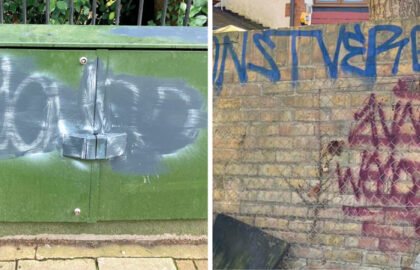In the second of a series of articles looking at local historic photos found in a 100-year-old family album, historian Richard Arnopp presents a selection of images of the Hobbs at their Forest Gate home
Last month, I introduced the Hobbs family, a talented and interesting clan, some of whom lived locally in Forest Gate and later Ilford. In 2017, I acquired an album, dated 1896–1907, containing over 100 photographs taken by family members.
The patriarch of the family was George Wilson Hobbs, a self-employed artist who had been born in Newport, Isle of Wight, in 1838. With his wife, Fanny, and their family, he moved to Forest Gate around 1880 and resided at 35 Bignold Road until his death in 1913. That house was the setting for a number of photographs from the album which will illustrate this instalment.
In those days, Forest Gate was rather different to what it is today – a quiet, lower-middle-class suburb containing an island of quite exclusive villas in the Woodgrange Estate. Mrs Dorothy Neal was born in 1912 in the corn chandler’s shop owned by her father in Dames Road – not 100 yards from the home of George Hobbs, with whom her life just overlapped. Looking back in 1981, she described the area thus:
“Forest Gate, when my father came here from North London in 1879, was just a village in the process of development. I am not certain of the date, but in Woodgrange Road where the Lister Centre now stands, was a toll gate, the old Toll House stood there for many years until the developers moved in. The Eagle and Child pub, before it was rebuilt, was a small inn called The Bird and Babe.
“Wanstead Flats was paradise for me. With my friends, we spent most of our school holidays in this pleasant place… There was a lovely bandstand where the band played every Thursday afternoon and Sunday during the summer months, and every evening a concert party entertained us – two pence (2d) for a seat inside the enclosure, or free if you cared to stand outside. We used to help arrange the seats, so got free admission. There were paddle and rowing boats on the pond, which appears to have dried up completely these days. On warm summer evenings, the Flats would be alive with people – the chocolate boys with their trays of sweets, and the old ice cream man with his barrow at the top of Capel Road. There were cricket pitches and tennis courts, protected by a single chain, supported by posts. We respected this and nobody trespassed the area.
“On Bank Holidays, the new Centre Road, which was then Woodford Road, was a blaze of lights with the arrival of the fair. The No. 5 trams would reach their destination just past Forest Road, packed with people from the Docklands area – no hooligans, just well-behaved people out to enjoy themselves.
“There were some very high-class shops in Woodgrange Road – Spratts and Raper & Dales being two outstanding ones with their beautiful arcades that looked like fairyland at Christmas. Along Forest Lane was a cab rank where the horse cabs lined up, waiting to pick up the City gents from the station. The horse trough, which is still there, was always filled with water for the horses, also a drinking fountain for everyone.
“I almost forgot the fire station in Forest Street, now Brooking Road – those gleaming fire engines, the firemen with their polished brass helmets, always in readiness for the fires that seemed so few in those days, in spite of open coal fires and candles that were very much in use. Yes, Forest Gate was a lovely place to live.”
To view Richard’s Wanstead Image Archive, visit wnstd.com/imagearchive







